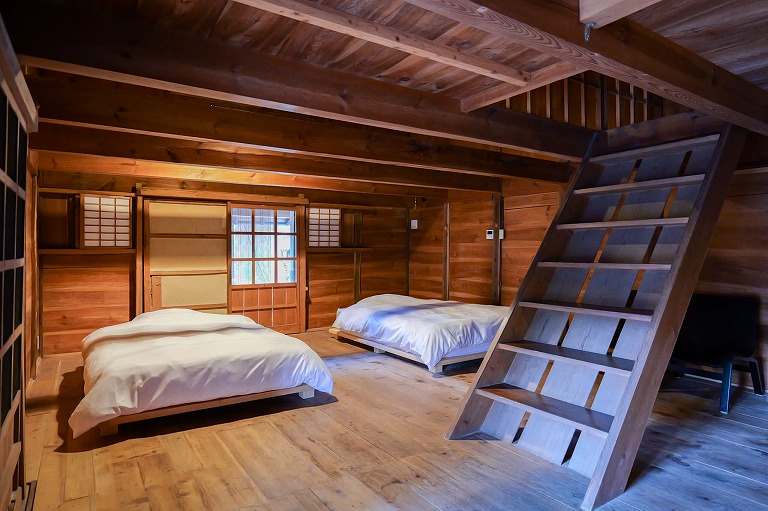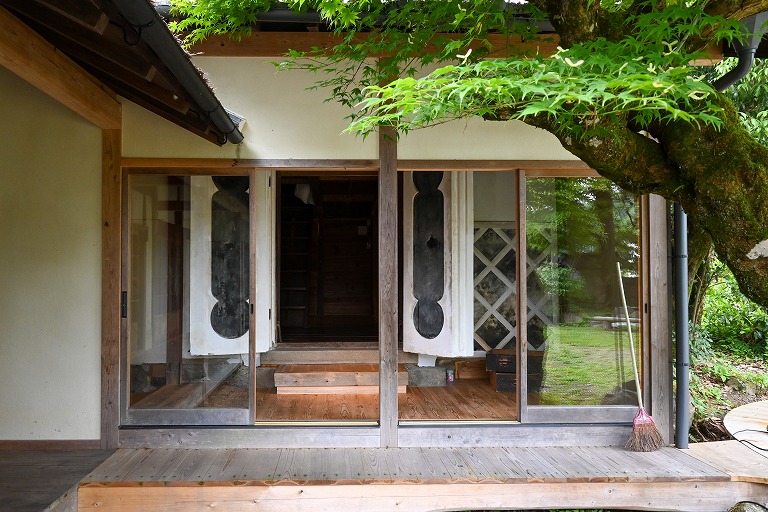Heading for Tamba-Sasayama, a village that lives with trees. A journey to encounter crafts born of forestry
Tamba-Sasayama is home to a variety of crafts that make use of natural materials, such as Tamba ware, Tamba fabric, and Tamba cotton. Currently, there are people in Tamba-Sasayama who are working on a new type of forestry that incorporates crafts.
This article introduces spots where you can experience forestry and daily life in the Oyamamiya area of Tamba-Sasayama City.
The people of Tamba-Sasayama living with forests

▲ mocca has opened under the theme of “Living with Trees.”
Japan has many mountains and little flat land, and two-thirds of the country is covered with forests. Tamba-Sasayama City is also a lush green city, with about 75% of its area forested. Nature is a source of extraordinary healing for visitors, but it is by no means all positive for the people who live there.
In fact, most of the forests in Tamba-Sasayama are artificial forests planted with Japanese cedar and cypress for lumber by people. If left unattended, these are at risk of landslides and mudslides, so they must be managed manually.
Moreover, because of the proximity of the forests to areas where people live, the farmland is always at risk of damage from wild animals. And this is not only a problem for Tamba-Sasayama, but also for Japan as a whole.
This issue will focus on people who live with trees, and introduce a stay that takes you one step further into the lives of the people of Tamba-Sasayama.
Creating a connection between forests and people. A new form of forestry that mocca is working on

The Oyamamiya area introduced here is about a 15-minute drive from the castle town area where Sasayama Castle, the tourist center of Tamba-Sasayama, is located. In contrast to the castle town area with its old samurai residences and merchant houses, the Oyamamiya area has many fields and feels closer to mountains and forests.
“mocca,” the first to be introduced, opened in 2020. A Japanese-style house that had been abandoned for about 30 years was renovated and transformed into a facility with five functions: a café, lodging, coworking space, craft workshop, and lumber mill, all under the theme of “living with trees.”
Mr. Naruto Tsuji, who is involved in the planning and operation of the project, is a forester engaged in the local forestry industry. He says that, while working at the city office to support agriculture, he began to see the challenges facing the forestry industry, such as animal damage that occurs around farmland.

▲ Café Space
The first thing that will strike visitors to mocca is its building, which was built approximately 160 years ago. Originally built as a mansion for a major landowner in the area, it is a large mansion that looks like something out of a movie. Although parts of the building that had been left to rot for many years have been repaired using modern construction methods, visitors can take in the beauty of Japanese architecture, with its skillful use of wood, that can be seen in the giant beams that support the ceiling.

The café's kitchen is open, with an impressive old-fashioned wood-fired kamado stove*, known locally as “okudo-san.” The okudo-san, surprisingly, is still active.
Since this is a wood-themed facility, there is only one gas stove. Basically, firewood is used, and when the cooking starts, the sound of burning wood and the smell of smoke permeate the area. The menu also includes sandwiches made with venison from the nearby mountains. All of them are profound experiences that cannot be enjoyed at ordinary hotels or tourist destinations, and are full of charm that will make you think, “It is great living with trees!”


A corner of the facility is decorated with crafts made of wood. Flowers and acorn-shaped game pieces made of thinly shaved wood are just some of the cute things that showcase the craftsmanship of the artisans.

The workshop is actually available for serious crafts with wood, but access is currently limited to registered community members.


The accommodation space overlooking an extensive garden is large enough to accommodate a great number of people. It is a lodge style with a kitchen, and the attractive thing is that visitors can stay for a long time as if they were living in the city. The bedrooms are renovated storehouses.


▲ The entrance to a bedroom
A sauna is currently under construction, which is sure to evolve into an even nicer place in the future.
*Kamado: A traditional Japanese earthenware cooking furnace used for cooking rice and simmering food. Wood or charcoal is used as fuel, and the pot is heated directly by the flame.
Yuji Nozawa’s Woodware Fills Life with Joy

Located about a 10-minute walk from mocca, Inatona is the atelier, gallery, and café of Yuji Nozawa, a woodworker who has moved here from Osaka. The shop sells wooden utensils, cutlery, trays, and other items that are warm and pleasant to the touch, all handmade by Mr. Nozawa.


In fact, for modern Japanese people, ceramics and porcelain are the most common types of vessels in daily use, and wooden vessels are not so familiar to them. You might think that they would be difficult to look after, but almost all of these wooden vessels are coated with Japanese lacquer, so they are durable, water-resistant, and can be cared for in the same way as ceramics and porcelain. When you touch it, the moist wood surface immediately feels comfortable in your hand.
In Wajima-nuri, famous in the Japanese woodware production region, items are usually painted with lacquer colored vermilion or black. This increases the strength of the wood, but the beauty of the grain in lost. Therefore, Mr. Nozawa boldly uses colorless lacquer to finish his works.

The wood used to make the woodware comes from local forestry workers, and sometimes Mr. Nozawa himself goes into the mountains to cut the wood himself. A great number of huge logs are piled at the entrance and in the yard.
Because wood contains a lot of moisture, it takes one to two years for the water to dry out before it can be sold as woodware. When you learn that, just as a tree takes a long time to grow, it also takes a lot of time and effort to make woodware, you grow more attached to it.
Woodware is lightweight and hard to break, making it an easy souvenir for travelers to take home.
The name “Inatona” means “adding joy to life.”
Several times a month, in cooperation with the local community, we also offer a lunch menu with plenty of local ingredients, so why not stop by to experience life with trees? (Reservations required)
mocca
Address: 510 Oyamamiya, Tanba-Sasayama City, Hyogo Prefecture 669-2802
Inatona
Address: 517 Oyamakami, Tamba-Sasayama City, Hyogo Prefecture 669-2803
Business hours: 12:00 am to 5:00 pm
* Winter December to March: Sunday and Monday only
* Spring through Fall: Sunday, Monday, Tuesday, Wednesday
Date : 2024.05.31



